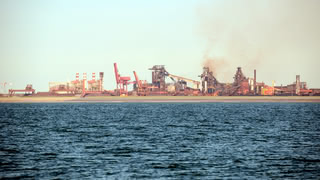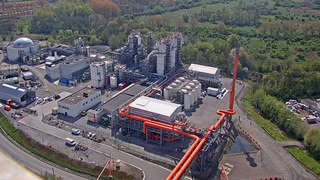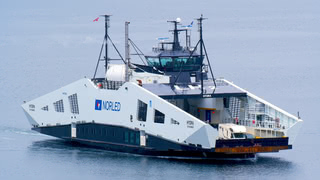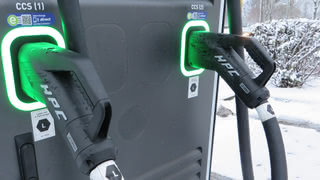Making Steel with Electricity
The Siderwin research project tested a new method of steelmaking that uses direct electrolysis of iron oxide in a pilot plant in France. The steelmaker ArcelorMittal now announced that it wants to commercialize the technology.
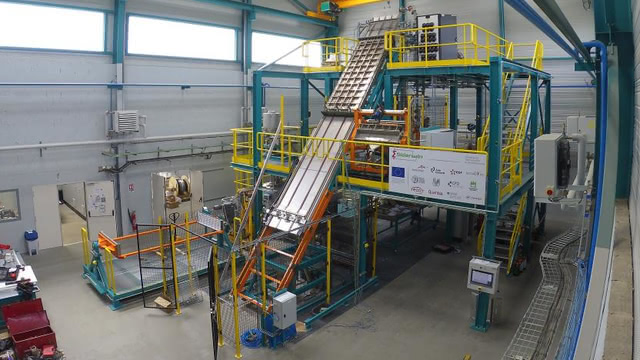
The production of steel is a significant contributor to climate change. Direct emissions from steelmaking are around 7 percent of worldwide carbon dioxide emissions.
Iron ore, the raw material used for steelmaking, contains iron oxide, which means the iron atoms are bound to oxygen atoms. To break this bond, the standard steelmaking process in blast furnaces uses coke made from cooking coal. This process creates large amounts of carbon dioxide emissions that cannot be avoided with the existing technology.
An alternative to blast furnaces is using hydrogen in a process called direct reduction. This is often considered the most promising technology for green steel production, and many steel companies have announced investments in it. I have covered this in an earlier newsletter.
Splitting Iron Oxide with Electricity
The project Siderwin has tested a different approach in a pilot plant in Maizières-lès-Metz, where the steel company ArcelorMittal operates a research facility. Siderwin uses direct electrolysis of iron oxide in a process called electrowinning. In other words: Pure electricity is used to split iron oxide into its elements. In a recent Webinar, the project presented some of its results – and ArcelorMittal announced that it wants to scale up the technology.
In the Siderwin plant, the iron oxide is dissolved in a solution between a nickel anode and a carbon cathode. An electric current splits the iron oxide and creates a layer of iron on the cathode. As the process creates not just iron but also oxygen, a challenge was to manage the flow of oxygen bubbles in the plant. The researchers used computational fluid dynamics to simulate the fluid flow and the oxygen bubbles, thereby getting an optimal design for the plant. The plant is a rectangular-shaped cell positioned diagonally so that the oxygen bubbles can move upwards.
Using direct electricity is likely more efficient than using hydrogen. However, this is not the only advantage the Siderwin project sees in its technology.
During the pilot phase, it was also tested to use waste products from other industries that contain iron oxide as a feedstock. According to Dimitrios Panias from the National Technical University of Athens, the most promising material tested was mill scale, a waste product from steel processing.
The project also tested other waste materials like bauxite residue, iron sludge, and ferritic slag. However, these turned out to lower the efficiency of the process substantially.
It was also modeled how this technology would impact the electricity market. According to Morgan Barberousse from the electricity company EDF, a partner in the project, converting all currently coal-based steel plants in Europe to the Siderwin technology would require an additional 471 terawatt hours per year. Part of the Siderwin concept is the idea that the technology can be used as a flexibility option in the electricity market.
"Siderwin technology is able to react fairly quickly in terms of ramp down." said Roland Kahmann, who analyzed the economics of the technology. "If you have this type of flexibility, you are able to generate an additional income literally in hundreds of millions per year for a typical plant size for Siderwin."
Different approaches with different temperatures
While all that sounds promising, in its test runs, the Siderwin plant only produced tens of kilograms each time. It is tiny compared to the industrial production of steel. (A typical steel plant can produce millions of tons per year.)
The Siderwin technology is not the only approach to apply direct electrolysis to steelmaking. Boston Metal is working on a process called molten oxide electrolysis. Interestingly, ArcelorMittal is an investor in Boston Metal, so the company is involved in two different approaches to iron oxide electrolysis.
While both approaches use electrolysis, there is a notable difference: Boston Metal's process uses hot iron oxide with high temperatures of about 1,600 °C. In contrast, Siderwin operates on relatively low temperatures of around 110 °C. Boston Metal already operates test cells of its technology that can produce hundreds of kilograms of steel per day, which is a significantly larger scale than the current Siderwin pilot.
A third approach to iron oxide electrolysis is developed by a US company called Elektra. With 60 °C, their process has an even lower temperature than Siderwin. Otherwise, they advertise similar to Siderwin: The possibility of using low-grade input materials and flexibility with renewable electricity input.
ArcelorMittal wants to commercialize the Siderwin technology
In the final presentation of the webinar, Valentine Weber-Zollinger from ArcelorMittal announced that the company has plans for the industrialization of the Siderwin technology. By 2025, ArcelorMittal expects an investment decision for a larger plant with a production capacity between 40,000 and 100,000 tons per year. By the end of the decade, ArcelorMittal could build a full-scale plant.
It still seems that hydrogen-based direct reduction is the most likely path to steel decarbonization for the near future. Even combined, all the current and announced projects using direct electrolysis are small compared to the pilot projects and plans by steel companies for hydrogen-based production. But iron oxide electrolysis is an interesting area to keep an eye on.
A recording of the mentioned webinar is available on YouTube.
Update: In June 2023, ArcelorMittal and John Cockerill announced the followup project to Siderwin called Volteron.
Author: Hanno Böck
Updates
In the last newsletter issue, I wrote that green ammonia imports would likely spell the end for ammonia factories in Europe. A day after I published the newsletter, BASF announced that it would shut down one of its ammonia plants in Ludwigshafen. (As a scientifically minded person, I obviously know correlation does not mean causation.)
There are no large-scale green ammonia imports yet, and the shutdown was motivated by current gas and energy prices. Still, it can be seen as a sign of what is to be expected.
Brief
-
Could magnesium from seawater be a key material for the future? An interesting article in the magazine Light Metal Age explores this.
-
The companies GE and IHI announced plans to develop gas turbines capable of burning 100% ammonia.
-
A report by the company Ambienta highlights the vital role of electrifying industrial heat.
-
Coolbrook and Linde announced a collaboration for the development of electric steam cracking, one of the key processes in the chemical industry that today is usually powered by fossil gas. Coolbrook is a Finnish company developing high-temperature electric heating processes.
